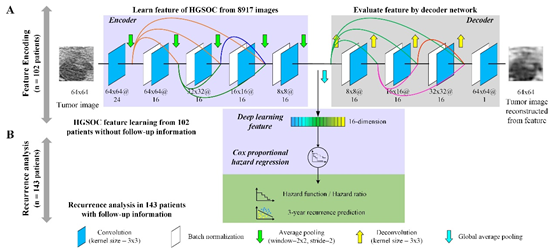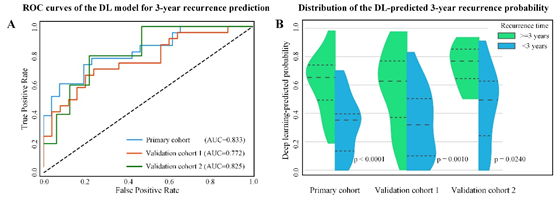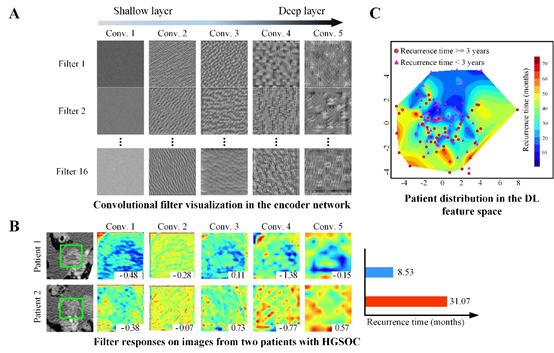Encoding High-grade Serous Ovarian Cancer by Deep Learning for Recurrence AnalysisEncoding High-grade Serous Ovarian Cancer by Deep Learning for Recurrence Analysis
Please click here to download the model.
We proposed a novel deep learning (DL) model for non-invasive and individualized recurrence prediction in high-grade serous ovarian cancer (HGSOC) based on preoperative computed tomography (CT) image. We used the DL network to mine the intrinsic characteristics (DL feature) of HGSOC from 8917 CT images in 102 patients. Afterwards, we developed a DL model incorporating Cox proportional hazard (Cox-PH) regression and the DL feature in the primary cohort (49 patients) for recurrence prediction. Results in the two independent validation cohorts (n = 49 and 45) demonstrated the model’s clinical application value (concordance-index = 0.713 and 0.694, area under the receiver operating characteristic curve = 0.772 and 0.825).
Using the DL model, clinicians can predict both the recurrence risk and 3-year recurrence probability preoperatively, which provides clinicians an effective tool for treatment and surveillance planning. In addition, the DL model is easy to use because it only requires tumor image without further human-assist such as tumor image segmentation. This makes the model easy-to-use for clinicians.
Moreover, the proposed DL model mines disease-specific features from data without follow-up, providing a new prognostic analysis method to utilize large amount of unlabeled data that miss follow-up.
To use this model, users only need to feed the region of interest (ROI) of the tumor CT image into the model. The DL network will extract the DL feature for the tumor, and use Cox proportional hazard model to predict the recurrence of patient.

Figure 1. The deep learning model.
(a) Mining the intrinsic characteristics of HGSOC by the proposed DL network. (b) Predicting recurrence by the learned DL feature.

Figure 2. Kaplan-Meier analysis of the DL model in the three cohorts (primary cohort, validation cohort 1 and validation cohort 2).

Figure 3. The 3-year recurrence prediction performance of the DL model.
(a) ROC curves of the DL model in the three cohorts. (b) The DL-predicted 3-year recurrence probability distribution.

Figure 4. Deep learning feature analysis.
(a) The convolutional filters (features) of the DL network. (b) The response of filters on tumors with different recurrence time. (c) The patient’s distribution in the DL feature space.